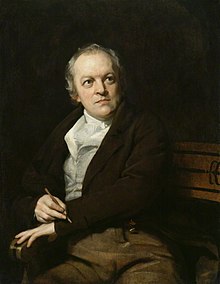Works Cited:
https://www.tate.org.uk/art/artists/william-blake-39
https://www.theartstory.org/artist-blake-william.htm
William Blake today is better known as a poet than as an artist but his emphasis on imagination and and emotional connection over the formality of Neo-classicism makes him stand out as one of the quintessential Romantic artists. In this sense he was also unique in how we applied his ideals to both art and writing. He was also known for his idiosyncratic views. I’m especially interested and fond of his involvement in the “free love” movement of the 19th century and seeing how he was ahead of his time. It advocated the freedom in sexual activity such as homosexuality, prostitution, adultery but was critical of marriage laws. Despite this, he is not without biblical subject matter in his works but he also rounds himself well with artworks based on literature and poetry which was his other profession. (Midsummer’s Dream-Oberon,Titiana and Puck. Macbeth-Pity.) Likewise, I also liked how his imagination can be seen in how he paints. His works were neither realistic nor idealistic but seem coming from a fever dream which is not far off considering how he spoke of spiritual visions in the adult life. His paintings convey his concept of imagination and inspiration in their grainy quality and their washed out, dulled colours.
 Newton (c. 1795)
Newton (c. 1795)
 Pity (c.1795)
Pity (c.1795)
 The Ancient of Days (c. 1794)
The Ancient of Days (c. 1794)
 Oberon, Titania and Puck with Fairies Dancing (c.1786)
Oberon, Titania and Puck with Fairies Dancing (c.1786)
 The Ghost of a Flea, (c. 1819–20
The Ghost of a Flea, (c. 1819–20

Geraldine,
Nice writing on Blake. Clear and precise filled with personal insights and observations. Only thing here is Blake fall in section 5; Realism, Pre-Impressionism, & Pre-Raphaelites. You have skipped Baroque and Neoclassicism, Romanticism, Rococo. I’m marking this Blake blog as #5. You still need to post on the above two.
Jeff
Jeff
Sorry for the mix up, when I looked up Romantism artists, Blake was listed there but I should’ve checked more. I’ll be doing new posts on both Baroque and Neo/Rom/Rococo so you can count Elizabeth as the final post.